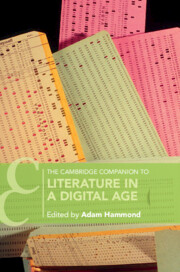Book contents
- The Cambridge Companion to Literature in a Digital Age
- The Cambridge Companion to Literature in a Digital Age
- Copyright page
- Contents
- Figures
- Contributors
- Chronology
- Introduction
- Chapter 1 Literary Data
- Chapter 2 Literary Change
- Chapter 3 The Canon
- Chapter 4 Voice and Performance
- Chapter 5 The Archive
- Chapter 6 Editions
- Chapter 7 Materiality
- Chapter 8 The Literary Marketplace
- Chapter 9 Fanfiction, Digital Platforms, and Social Reading
- Chapter 10 Narrative and Interactivity
- Chapter 11 Generated Literature
- Chapter 12 Literary Gaming
- Chapter 13 The Printed Book in the Digital Age
- Chapter 14 Literature’s Audioptic Platform
- Chapter 15 Critique
- Index
- Cambridge Companions To Literature
Chapter 10 - Narrative and Interactivity
Published online by Cambridge University Press: 29 November 2024
- The Cambridge Companion to Literature in a Digital Age
- The Cambridge Companion to Literature in a Digital Age
- Copyright page
- Contents
- Figures
- Contributors
- Chronology
- Introduction
- Chapter 1 Literary Data
- Chapter 2 Literary Change
- Chapter 3 The Canon
- Chapter 4 Voice and Performance
- Chapter 5 The Archive
- Chapter 6 Editions
- Chapter 7 Materiality
- Chapter 8 The Literary Marketplace
- Chapter 9 Fanfiction, Digital Platforms, and Social Reading
- Chapter 10 Narrative and Interactivity
- Chapter 11 Generated Literature
- Chapter 12 Literary Gaming
- Chapter 13 The Printed Book in the Digital Age
- Chapter 14 Literature’s Audioptic Platform
- Chapter 15 Critique
- Index
- Cambridge Companions To Literature
Summary
This chapter offers an assessment of the challenges that interactive forms of digital literature pose to print-based assumptions about narrative. The assertions of critics such as Espen Aarseth, Janet Murray, and Bolter and Landow – that the interactivity of digital texts invalidates such core assumptions as the distinction between fabula and syuzhet as well as author, reader, and character – have tended to lose their force as the genres they regarded as transformative – hypertext fiction and text-based interactive fiction (IF) – have receded from public view. Yet, as Emily Short argues here, these genres are far from “dead.” Speaking from her perspective as one of contemporary literature’s most highly regarded authors of interactive and choice-based literature, Short shows that interactive fiction has not disappeared, but rather become so thoroughly ingrained in contemporary artistic practice as to become nearly invisible – not only in hypertextual forms like the popular videogames authored in the Twine platform, but also in contemporary print-based literary fiction. In thus penetrating the mainstream of literary production, both digital and analog, interactive forms have subtly but powerfully revised our core assumptions about literary narrative.
- Type
- Chapter
- Information
- The Cambridge Companion to Literature in a Digital Age , pp. 177 - 193Publisher: Cambridge University PressPrint publication year: 2024

